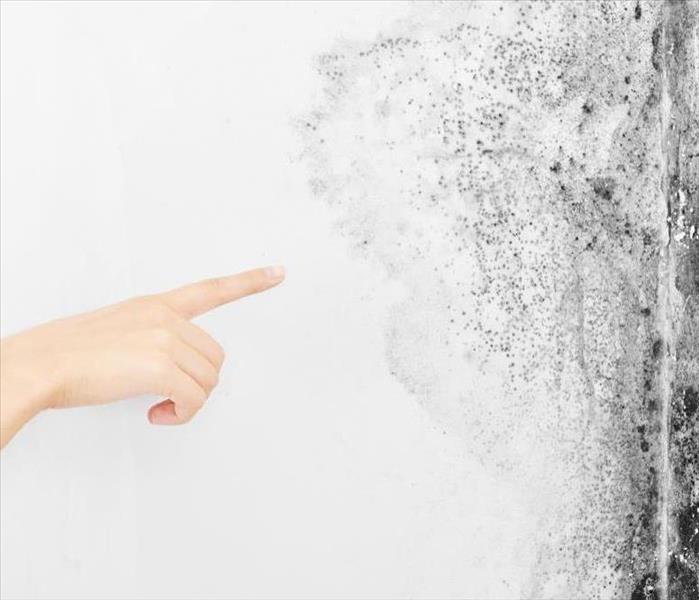Mold Remediation: Top Signs and Causes of Mold Infestation in Homes
3/11/2020 (Permalink)
Mold growth is more common in homes located in flood-prone areas, but it can occur in any home. It looks unsightly, but can also cause major structural damage if left unattended for a long time.
The best way to deal with infestation of this annoying fungus is to be proactive. Being proactive here means you should know the signs and causes mold growth, so you can address the problem immediately and stop it in its tracks.
How to Tell if There is a Mold Problem in Your Home
If you notice any of the following signs in your home, you could be having a mold problem:
- Can you see colored, flat spots or fluffy patches forming on the walls, ceilings or floors of your dwelling?
- Do you notice a pungent or musty odor when you enter your house?
- Can you see water stains on your walls, ceilings, floors and other surfaces?
- Is the paint on the interior surfaces of your abode coming or peeling off?
- Do you have rusty water pipes in your abode?
If the answer to one or more of these questions is a resounding yes, you might have a mold problem in your home.
4 Common Causes of Mold Infestation in Homes
Mold thrives in areas that stay wet, and none will grow on surfaces without direct exposure to oxygen. Besides flooding, there are many other potential water or moisture sources that could encourage its growth within a home.
Continue reading on below to find out a few “typical” culprits behind mold growth and damage in homes.
1. Leaky Water Pipes
Every home requires a consistent supply of clean water for drinking, cooking, cleaning dirty dishes, bathing, doing laundry, and more. Surviving a day without running water is almost unimaginable.
The water connection to your abode comprises a series of water pipes that deliver water to the various faucets or points of use within the home.
When you have a dripping water pipe, you may experience a considerable decline in water pressure, depending on how big or small the leak is. But that is not the only thing that should worry you.
The water leakage may encourage mold infestation, especially if it’s hidden and goes unnoticed for a long time. Leaks that occur underneath sinks installed on bathroom vanities are a perfect example of leaks that may take time to detect.
Once you have called in an emergency plumber to stop the leakage, you should immediately contact a remediation specialist to inspect the affected area for mold growth and determine the extent of damage caused by the mold.
2. Leaky Roofs
Like dripping water pipes, leaky roofs are another common cause of mold damage. Mold growth from roof leaks typically happens during the rainy spell when rainwater runs off the rooftop.
The presence of water stains on your ceiling or interior walls is a tell-tale sign of a leak from above. A roof repair specialist can fix the leaks for you, but they may not have the expertise and experience required to inspect your roof and home for mold damage.
You will need to enlist the services of a water and mold damage professional to protect your family from mold exposure and growth in your home.
3. Hot Showers
Bathrooms are by design wet areas, but are you aware that those long, foggy hot showers you like taking every day could increase the risk of mold growth?
Hot showers cause moisture-heavy air, called condensation, to build up on your bathroom surfaces. This, in turn, encourages mold growth in your bathroom.
To minimize condensation and prevent this growth in your bathroom, you should consider leaving your bathroom windows open when taking hot showers.
When opened, your bathroom windows will allow excess moisture to exit the room to the outdoors. To facilitate quicker expulsion of excess moisture from your bathroom, you should consider installing a ventilator fan.
4. Drafty Doors and Windows
Doors and windows that leak out air are a leading source of energy inefficiency in homes, but they could also promote mold growth by leaking in water from outside when it rains.
Luckily, all you may need to do to remedy the problem is to replace the caulking or weather-stripping around the window.
If you suspect that your house has suffered mold damage, it is best to contact a remediation expert immediately. This will ensure prompt removal as well as prevention of further damage.
Contact SERVPRO for Help
Mold spreads fast, so any sign of growth requires prompt intervention. If you have an infestation in your Murfreesboro home, don’t hesitate to turn to the seasoned remediation specialists at SERVPRO for help.




 24/7 Emergency Service
24/7 Emergency Service
